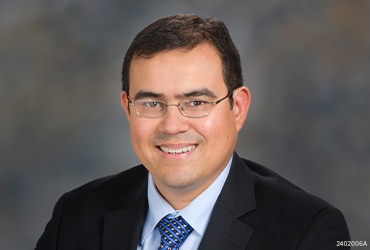TTFields: A Potential Treatment of Spinal Metastases
By Alice Bradbury, PhD
Spinal metastasis is a challenging complication of cancer which can result in spinal cord compression, neurological compromise, and decreased overall survival. Surgery and radiation are mainstays of treatment; however, patients often progress and have limited additional treatment options (1). Tumor Treating Fields (TTFields) are intermediate frequency (100-500kHz), low intensity (1-3 V/cm), alternating electric fields that disrupt cellular processes critical for cancer viability and tumor progression, ultimately leading to cell death (2). A recent study published in JCI Insight revealed how this emerging treatment modality could be leveraged as local therapy in the treatment of spinal metastases (3).

The study was led by Professor Claudio E. Tatsui, MD and Assistant Professor Christopher A. Alvarez-Breckenridge, MD, PhD, at the University of Texas MD Anderson Cancer Center. A recipient of the 2021 AACR-Novocure Tumor Treating Fields Research Grant, Dr. Tatsui began investigating the ability of TTFields to inhibit the growth of spinal metastasis in in vitro and in vivo models. To build on the findings from this study, Dr. Alvarez-Breckenridge was awarded the AACR-Novocure Career Development Award for Cancer Research in 2023 for his research project in which he aims to delineate the effects of TTFields on the bone microenvironment and on innate and adaptive immunity.
As part of a collaborative group of spinal neurosurgical oncologists, Dr. Tatsui and Dr. Alvarez-Breckenridge leveraged their collaboration to drive the study, saying, “As we face recurring challenges in the clinical setting, we have been able to return to our collaborative laboratory to explore novel treatment approaches, investigate their underlying mechanism of action, and finally work to implement our research discoveries into improved ways of delivering care to our patients.”

In this study, the researchers began by modeling the application of TTFields in the setting of spinal metastases. Using a computational phantom of a healthy 26-year-old, they simulated a typical surgical approach to address recurrent metastatic spinal cord compression, then simulated non-invasive transcutaneous delivery of 150 kHz TTFields. Due to its lower conductivity, the results predicted substantial increase of TTFields intensity in the residual vertebral bone of the resected tumor (2-3 V/cm), compared to the surrounding areas (<1 V/cm).
With the modeling data supporting enhanced TTFields distribution in bone, the team then evaluated the ability of TTFields to inhibit the growth of KRIB-mCherry-luciferase (KRIB-mLuc) osteosarcoma and A549-mCherry-luciferase (A549-mLuc) lung adenocarcinoma cell lines seeded in bone grafts. They found that 150 kHz TTFields resulted in significant growth inhibition in both graft models compared to control. Furthermore, they found that the metallic properties of titanium screws, which are often necessary to stabilize the spine in the treatment of spinal tumors, did not disrupt the inhibitory effect of TTFields on tumor growth when added to the bone grafts.
The researchers then orthotopically implanted KRIB-mLuc cells into the vertebral body of the lumbar spine in athymic nude mice. After confirming tumor engraftment with bioluminescence imaging (BLI), they randomly assigned mice to sham control (heat) or 150 kHz TTFields exposure, delivered via flexible torso-transducer arrays. Mice in the TTFields group demonstrated a significantly lower BLI signal (indicating decreased KRIB-mLuc tumor cell growth), compared to mice in the control group. They also evaluated neurological symptoms corresponding to the degree of spinal compression resulting from tumor growth and found that mice treated with TTFields showed a delay in development of symptoms including tail drop, dorsal sweeping, hind leg sweeping and hind limb paralysis, or developed no symptoms at all. Consistent with the severe neurological decline seen in the control mice, MRI imaging revealed that tumors invaded multiple vertebral levels, paraspinal musculature, and caused substantial compression of the thecal sac and spinal cord, while tumors in the TTFields-exposed mice remained confined to the implanted vertebral body.
Outlining the broader implications for their research, Drs. Tatsui and Alvarez-Breckenridge shared, “As part of our clinical practice, we frequently encounter patients with metastatic disease progression in their spine that leads to significant spinal cord compression. While surgery and radiation are the mainstays of treatment, we struggle once patients have progressed following these lines of therapy and have limited additional treatment options. Our study exploring the utility of Tumor Treating Fields for spinal metastases provides a novel treatment approach for this patient population that we are eager to translate into the clinical setting.”
They also acknowledged how the support from AACR and Novocure has positively impacted their research program, saying, “The support from AACR-Novocure was instrumental in supporting our work on Tumor Treating Fields for spinal metastases. In addition to providing the critical equipment, the financial support was instrumental in carrying out the initial proof-of-concept experiments that have established the foundation for a larger research program. We are incredibly grateful for this support and are eager to continue our collaborative research efforts to provide novel treatment options for our patients.”
References
- Kelly ML, Benzel EC. Surgery Versus Radiation Therapy Alone in Treating Spinal Metastasis: A Perspective. World Neurosurg. 2015 Jun;83(6):1020-1.
- Pohling C, Nguyen H, Chang E, Schubert KE, Nje Y, Bashkirov V, et al. Current status of the preclinical evaluation of alternating electric fields as a form of cancer therapy. Bioelectrochemistry. 2023;149:108287.
- Ledbetter D, de Almeida RAA. Wu X, Naveh A, Patel CB, Gonzalez Q, et al. Tumor treating fields suppress tumor cell growth and neurologic decline in models of spinal metastases. JCI Insight. 2024 Mar 21;9(9):e176962.